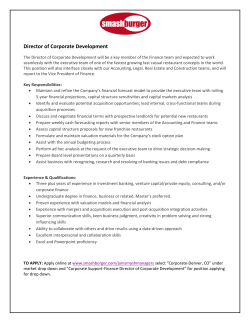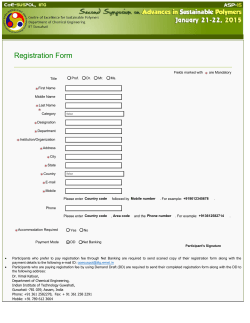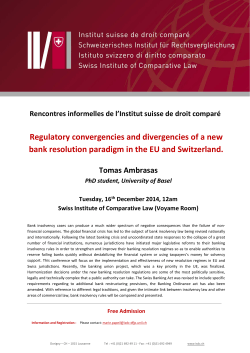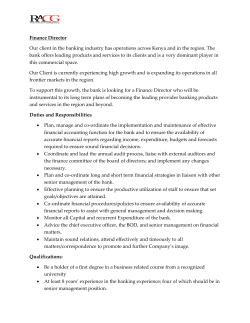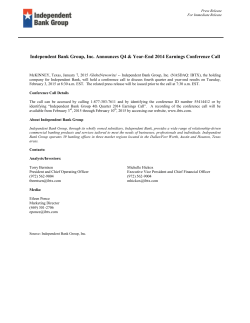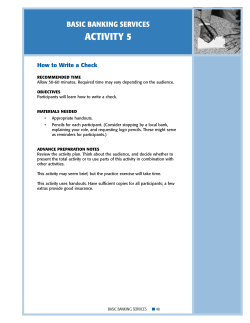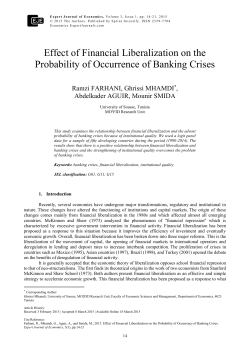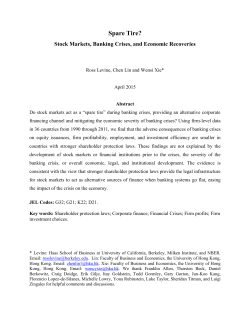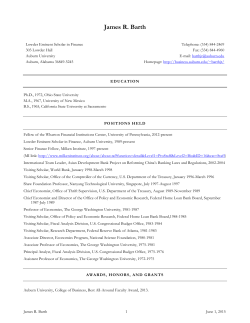
ДИСКУ С СИИ
Indicative approach to banking crises: case of Russia Kiselev V. HSE graduate student, Department of Finance.. корпоративные финансы J. of сorporate finance research выпуск №4(28), 2013 © корпоративные финансы, 2014 ДИСКУССИИ Abstract 99 This article presents approach to build indicator for financial instability in the banking sector by constructing the indices of structural changes in its aggregate balance. From our view such approach promotes transformation the concept of banking crisis into numerical value. In this article the term «banking crisis» is treated as event when appears the risk of stoppage the going concern in banking industry and banking sector not have enough resources to eliminate such risk independently without public or other kind of external support. The main thesis in this paper is that the consequence of banking crisis should cause sufficient changes of the banking balance structure. In order to find support for this concept we going briefly through the cases of the banking sector in Russia during 1992-2013 time period and describe the major changes in the structure of banking business. The estimated part of the article based on data from official reporting form of banking balance for commercial banks on monthly basis starting from 2007. The aggregated balance of Russian banking sector in this article contains 13 items for assets side and 15 items for liability side. Index of structural changes estimated as average value of yearly absolute change in weight of item in balance sheet. Two indices for asset and liability sides of balance sheet were built separately. In addition the yearly growth rate of aggregate profit was calculated. The results in the article has shown that banking crisis in 2008 caused the significant changes in balance sheet structure and banking business model in Russia. Keywords: banking crises, forecasting, early-warning systems, finance, bank balance sheet, finance JEL: C51, G32, G18 References 1. Caprio G., Klingebiel D. Bank insolvencies: cross-country experience. The World Bank Policy Research Department, 1996, #1620. 2. Caprio G., Klingebiel D. Episodes of systemic and borderline financial crises. World Bank, 2003. 3. Demirguc-Kunt A., Detragiache E. Cross-Country empirical studies of systemic bank distress: A survey, 2005, # 05/96. 4. Drobyshevskii S. M., Trunin P.V., Palii A.A, Knobel’ A.Iu. Nekotorye podkhody k razrabotke sistemy indikatorov monitoringa finansovoi stabil’nosti [Some approaches to development of a system of financial stability monitoring indicators]. Institut ekonomiki perekhodnogo perioda. Nauchnye trudy. [Institute of transition economy. Proceedings], 2006, № 103R. 5. Ershov M.V. Mirovoi finansovyi krizis. Chto dal’she? [Global financial crisis. What further?] Moscow, Ekonomika, 2011. 6. Laeven L. Banking crises database, 2010. Available at: http://www.lucleaven.com. 7. Laeven L., Valencia F. Systemic banking crises database: an update. International Monetary Fund Working Paper, 2012. 8. Struchevskii A. Empiricheskii analiz finansovykh krizisov v Rossii [Empirical analysis of financial crises in Russia]. Ekonomicheskii zhurnal VShE [Economic journal of HSE], 1998, № 2, pp. 197–209. 9. Struchevskii A.A. Makroekonomicheskie predposylki finansovogo krizisa 1998 g. [Macroeconomic assumptions of the financial crisis of 1998]. Ekonomicheskii zhurnal VShE [Economic journal of HSE], 1999. № 1, pp. 82–100. 10. Trunin P.V. Metodologicheskie podkhody k razrabotke i obosnovaniiu indikatorov-predvestnikov finansovoi nestabil’nosti v Rossii [Methodological approaches to development and substantiation of leading indicators of financial instability in Russia]. Moscow, Institut ekonomiki perekhodnogo perioda [Institute of transition economy], 2007.
© Copyright 2025
